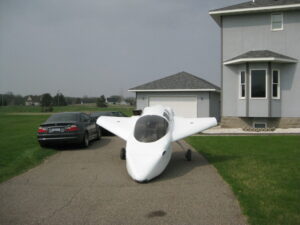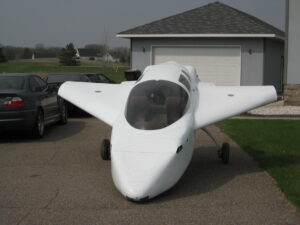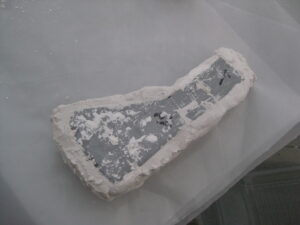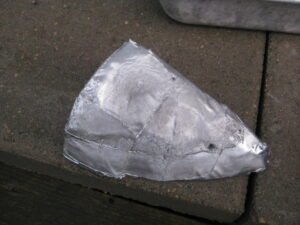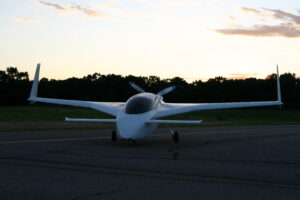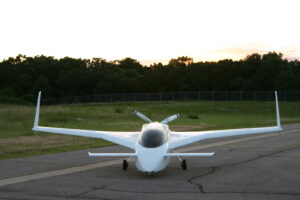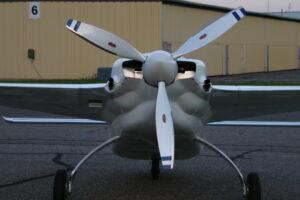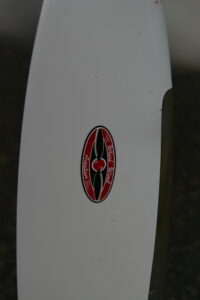There are three categories of preparations to address. First, the plane’s physical readiness. Second, the plane’s legal (paperwork) readiness. Third, and every bit as critical as the first, is the test pilot’s readiness.
We’ll start this section with the big move of the airplane from the garage to the hangar. Fortunately for us the move went pretty smoothly. We had taken the wings and canard up to the hangar a few months ago in order to free up space in the garage. We decided that we’d transport the fuselage with the engine installed, but the prop in it’s shipping crate. Using a standard 1/2 ton truck and a car trailer we loaded the plane up for the 20 mile journey to St. Cloud Regional Airport (KSTC). We simply strapped the plane down good using the F22 bulkhead and the MLG, and drove cautiously to the hangar. The only trouble we NEARLY had, was that the access gate was only about 4 inches wider than the spar. It was a very Cozy fit to get through the gate, but once through we quickly unloaded it from the trailer and we returned to a rather lonely feeling garage.
It is said that the paperwork is not complete until it weighs as much as the plane. In truth it’s not really that bad, but it is advisable to start the process at least a few months before one THINKS (things never go as smoothly as planned) they are going to be ready for first flight. The first step in the process is to apply for registration either with a reserved N number, a list of preferred N numbers, or simply have it assigned. We’ve had N204TF reserved for our plane for a while. Our registration took about a month to get back from the FAA, which is about what the FAA advises the process takes. With our registration complete, it was legal for us to attach the N numbers to the plane. We’ve also been busy modifying the POH to fit our plane, as well as checklists, and condition inspection procedures. We have also been writing up the complete flight test program, using guidance from AC90-89A, as well as the Cozy POH, and procedures from other builders. These documents can be downloaded below:
N204TF POH
N204TF Checklist
N204TF Flight Test Program Letter
N204TF Flight Test Cards (.zip)
N204TF Ground Crew Emergency Procedures
With the airplane now at the hangar, we found our nightly work on it to need to be well planned out. Forgetting a tool or part at home would mean wasting part of the evening, or having to make a run home and back on a weekend. After we reattached the wings and canard to the plane we discovered an issue with our emergency gear extension rod interfering with the elevator torque tube. The issue and resolution is detailed on the Chapter 13 page.
We then started working through a complete condition inspection, as well as pre airframe engine startup procedures. We conducted a fuel flow test, an unusable fuel test, and a cold compression test. Upon first startup of the engine on the airframe we were able to determine the real cause for the secondary ignition system trouble we had during the test cell run-in. The crank angle sensor (known as the Mag Timing Housing on the ElectroAir ignition), was dead. We ordered a replacement and will move on to finishing up other little odds and ends while we wait for it. You can see the video of the first run of the engine on the airframe here.
One of the last little projects we needed to finish before applying for our airworthiness certificate is to make the ballast weights for the nose cone. N204TF is rather rear heavy due to the large angle valve engine, and the constant speed prop. The dual batteries for the electrical system don’t help much either. All of this means that her empty weight came in at 1248lbs, with a CG of 113.3″, and solo pilot operations will require a lot of ballast. In order to get as much weight as possible as far forward as possible we made foam plug molds to make lead weights from. We shaped these six foam plugs in order to maximize the amount of space we could fill in the forward nose ballast compartment. We then covered the foam with duct tape, and covered that with plaster. After the plaster cured, we dug out the foam and tape leaving the empty plaster cast. We then melted down lead dive weights on our gas grill (1, 2, and 4lbs at a time). You absolutely must do this outside, and wear a charcoal respirator, you do not want to breathe any of the lead fumes. 4lbs seemed to be about the most you would want to pour at any given time. We let each pour cool for about 30 minutes before we poured another layer on top. Once each mold was full we broke the plaster off leaving just the lead weight. We then covered each piece with duct tape and wrote the weight on each, 62lbs in total. With the plane ready to go we called our EAA tech counselor and local FAA DAR, Tim Mahoney.
While Tim was already familiar with our project, serving as our EAA Tech Counselor, he made certain to go over 4TF with carefully. Tim found a few things that we needed to correct (orientation of a couple bolts, replacing a couple of stop nuts with castle nuts, etc), fortunately these were all correctable on the spot while Tim was continuing his inspection. At the end of the inspection we took one of the proudest photos we have taken during this project, Tim handing us all the Airworthiness Certification for N204TF. The Spirit of Adventure was officially born. Her name has been chosen as a tribute not only to the many adventures we hope to have with the plane, but also the wonderful and amazing adventure we had in building it. There were many times during construction when we wonder if we had the skills needed, and many times when giving up would have been the easiest option. Deep in our hearts we knew from the beginning this was a project we had to see through to the end. The things we’ve learned, and the laughs we’ve shared have been worth the very few frustrations.
Over the course of building, and especially as we approached this point, we discussed the topic of who would test pilot 4TF for it’s maiden flight. Some see the choice as easy, but for us, and especially for John, it was no easy choice. At this point John has been flying for about 11 years, and has about 250 hours total flight time. Most of this time has been spent in Cessna and Piper aircraft, with only one flight in a Cozy. While John knew he was not an ideal test pilot, the possibility of someone being hurt during that first flight in the plane we built, made it impossible for us to allow anyone else to conduct the testing. In order to become as prepared as possible, John’s next task was to get training in as many different types of planes possible, including additional canard time. After flying various Cessna, Piper, Beechcraft, and Cirrus aircraft, the last preparatory flight John would take was with a local Velocity driver, Jim Slate. Many thanks to Jim for the training on the subtleties of flying (and landing!) canard airplanes. The last thing to do was wait for good weather…

